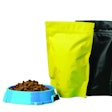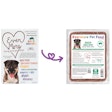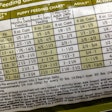
For several years now, the Association of American Feed Control Officials (AAFCO) has been working on regulatory changes with the goal of improving the readability and transparency of the information as it must appear on the pet food label. Reports on the progress made by the four subgroups within the Pet Food Labeling Modernization Working Group were provided at the Pet Food Committee session at the AAFCO meeting held on January 21–23, 2020, in Albuquerque, New Mexico, USA.
Pet nutrition facts box
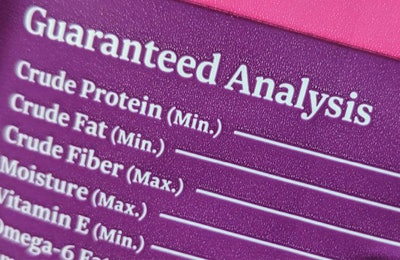
Simplified terminology (such as changing “crude protein” to “protein”) is one of the changes under consideration. | Andrea Gantz, WATT Global Media
This subgroup has devised a means to provide nutrition information similar to as it may appear on a label of a food intended for human consumption; i.e., a discrete, easily identifiable section of the label that succinctly conveys information about nutrient and calorie content to the consumer. Similar to a human food label, all labels would present the information in the same font, colors, etc., so the purchaser can locate such information and easily compare and contrast it with the same information on other product labels. Guarantees in percentages, etc., as they presently appear on labels will remain, but other means of nutrient expression (e.g., grams per cup) will be added. Terminology will be simplified as well; e.g., "protein" instead of "crude protein."
After several renditions of the "Pet Nutrition Facts Box" were made public and consumer focus group feedback received, the subgroup is narrowing down the details as to exactly what information it will contain. Still a matter of deliberation is the required information concerning carbohydrate content. The replacement of crude fiber with a more nutritionally appropriate indicator (i.e., total dietary fiber) appears almost definite. How to declare related information (e.g., based on a calculated "non-fiber carbohydrate" value versus a more specific "starch and sugars" analysis) is yet to be decided.
Nutritional adequacy
A means to quickly and clearly convey the intended nutritional adequacy of a product has been developed with the creation of standardized graphics that are to appear on the principal display panel of all pet food product labels. For "complete and balanced" dog and cat foods, a circle bearing these words (along with any limitations as to life stage or size) in prescribed colors and font will appear in the same general location, and be of a minimum type size relative to the area of the panel.
The detailed nutritional adequacy statement as already required on the back panels of pet food labels will remain, but with the addition of this front-of-pack graphic purchasers can easily survey shelves of product (both within and between brands and product lines) to find the products most suitable for their individual pet's nutritional needs.
The intent also is to expressly identify products that are not complete and balanced with a different graphic on the front panel. However, finding succinct wording that would sufficiently cover the broad variety of foods in this category (not only snacks and treats, but also supplements, toppers, mixers, etc.) has proven to be a challenge. It is most likely that several options will be made available, such as "snack," "treat" or "(food) supplement," but in all cases the wording would appear in a discrete black-and-white rectangle on the principal display panel. A third graphic intended for inclusion on therapeutic pet food labels is also planned.
Ingredients
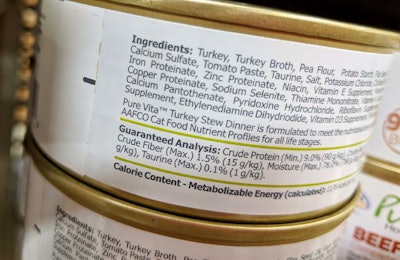
With respect to listed ingredients, not much is likely to change from current standard practice. | Andrea Gantz, WATT Global Media
Many ideas to modernize the ingredient declaration on the label of pet foods were considered, but in the end likely little is going to change. For example, provisions in current U.S. Food and Drug Administration (FDA) regulations to allow for "may contain one or more of the following" declarations to accommodate seasonal and other variations in fish species and oil blends on human food labels were rejected by AAFCO. Plans to consider more consumer-friendly verbiage for many ingredient names, including many of the vitamins, was deemed to be beyond the scope of this subgroup and the matter has moved to the Ingredient Definitions Committee for any further consideration.
The proposed revisions to the AAFCO regulations will codify what has been common practice. For example, the grouping of vitamin and mineral premixes in the ingredient declaration, which has been tolerated but not formally permitted for many years, would become expressly allowed. Bottom line, then, notwithstanding the intent to "modernize" labels, at least with respect to ingredients it should not have significant impact on current labeling.
Safe handling directions
A series of graphics, each with accompanying explanatory text, has been developed to help advise purchasers of proper use and handling of products to mitigate safety issues. These would be added to pet food labels as appropriate depending on the type of product. For example, "store in a cool, dry place" may be appropriate for a dry food, while "keep frozen" or "refrigerate open container" may be more suitable for other forms. The subgroup intends to wrap up its charge soon.
What's next?
Some subgroups have made more progress than others, but all are in their finishing stages. Eventually, all recommendations, including any proposed regulatory amendments, will be submitted to the Pet Food Committee for review and approval. These will need to further move through the Model Bills & Regulations Committee and, finally, must be voted on by the full AAFCO membership before they are enacted. In other words, notwithstanding the years already put into these efforts, it may take a couple of more for all proposals to move through the full process.
Because these proposals will fundamentally change how products must be labeled, the goal is to have all the regulatory amendments implemented simultaneously. In this way, manufacturers can incorporate all needed label revisions in one swoop, rather than piecemeal. The establishment of a generous grace period from enforcement is anticipated (years?). Still, the transition from the current to new labeling will be an onerous task for both industry and regulators. Hopefully, these incredible efforts will be proven worth it to the ultimate benefit to the consumer.







